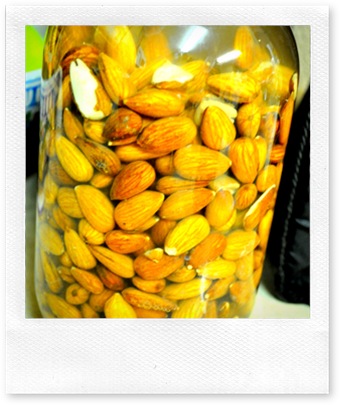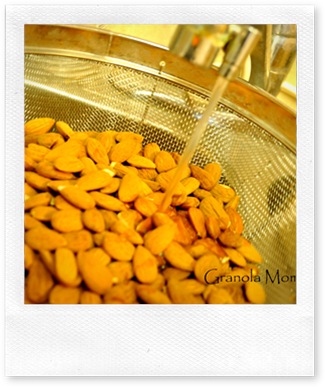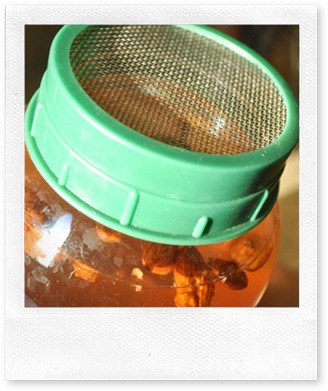Soaking and Sprouting Almonds
Well, as you know . . . we had a bit of an almond problem. 15 pounds worth of almonds. (Melanie, you almonds will be coming soon!) When I ordered the almonds I had to estimate how many pounds we would eat in a year. But when I rationed the almonds into 12 neat bags . . . it sure didn’t look like a lot of almonds per approximately 30 days.
Our almonds are completely raw. So they had some dirt on them. I washed the dirt off and looked for rocks.
I dumped my freshly bathed almonds into my sprouting jar and filled it with filtered water.
Now, to soak your almonds you DO NOT need a fancy jar with a mesh wire lid, such as mine. My mom “happened” to give this jar to me. I do recommend a large jar like this—BUT a 1/2 gallon Mason jar works nicely and so does a Pyrex bowl. When I don’t have a mesh lid, I cover the top of the jar with a clean wash cloth and secure it with a rubber band.
Sprouted almonds are supposed to be rinsed 3-4 times a day. Hold on to the lid, pour the water into the sink, rinse off the almonds, dump the water, and add more filtered water.
Allow your almonds to soak until you see a 1/8 inch sprout at the tip of your nut. Your almonds will have almost doubled in size.

Cute little itty bitty tiny whinny sprout . . .
Time to dehydrate the almonds. If you do not have a dehydrator you can store soaked almonds in your fridge for 2 days and eat them raw. Or place them on a cookie sheet and dry them at the lowest temperature your oven will allow – anywhere from 12-24 hours! You can add salt or seasonings to your wet almonds.

Notice the difference between a sprouted almond and a store bought almond. They do taste different. I personally only like soaked and sprouted almonds.
And remember soaked and sprouted beans, nuts, and grains are nutritionally better for you. By soaking you are allowing the plant to basically pre-digest parts of itself to make it easier for your body to digest and make the nutrients readily accessible to your body.






ahhh this makes a lot of sense! I never dehydrated or put them in the oven after soaking… they do.not.last.long! haha 🙂 YAY! I love learning new things on your blog!
Looking forward to trying this – thanks for the tutorial!
=)
that was really interesting … I had no idea it took so much to get the BEST out of an almond. 🙂 Almonds are among the few nuts I'm not allergic to so I'm glad to hear this information.
where did you get that straining lid?
Thanks for sharing! I have a bunch of almonds that I need to sprout too! I soaked them and put them in the refrigorator and they didn't last long. Very glad to know this info about putting them in the oven! 🙂 How long do they last after that?
This is great! I loved reading this. I was just reading a Sue Gregg tutorial on making almond milk ~ I think you should try it! *Ü*
Just the info I needed! soaking some right now for us and the cockatiels. I never would have though to dehydrate them, might have to try that too!
Hi. Once the almonds have sprouted, do you drain the water and then put the almonds in the refrigerator? Or do you put the almonds in the jar filled with water in the fridge?
Thank you
I then dehydrate them with a bit of Celtic Sea Salt!
Great post! Right on about getting into the LIVING FOODS! Sprouted almonds are where it’s at! Apparantly sprouting increases the vitamin content several hundred %!!
It can be quite difficult to get your hands on TRULY raw unpasteurized almonds, even the ones that say raw usually are still pateurised. But as you show, if the nub sprouts out like that then it really is raw!
Thanks for posting!
Hi Jodi,
Would it affect the sprouting process if I use a closed lid vs a mesh lid? Also, I’m in a rather hot and humid-weathered country. Does that mean I should put them in the fridge while soaking? Thanks!